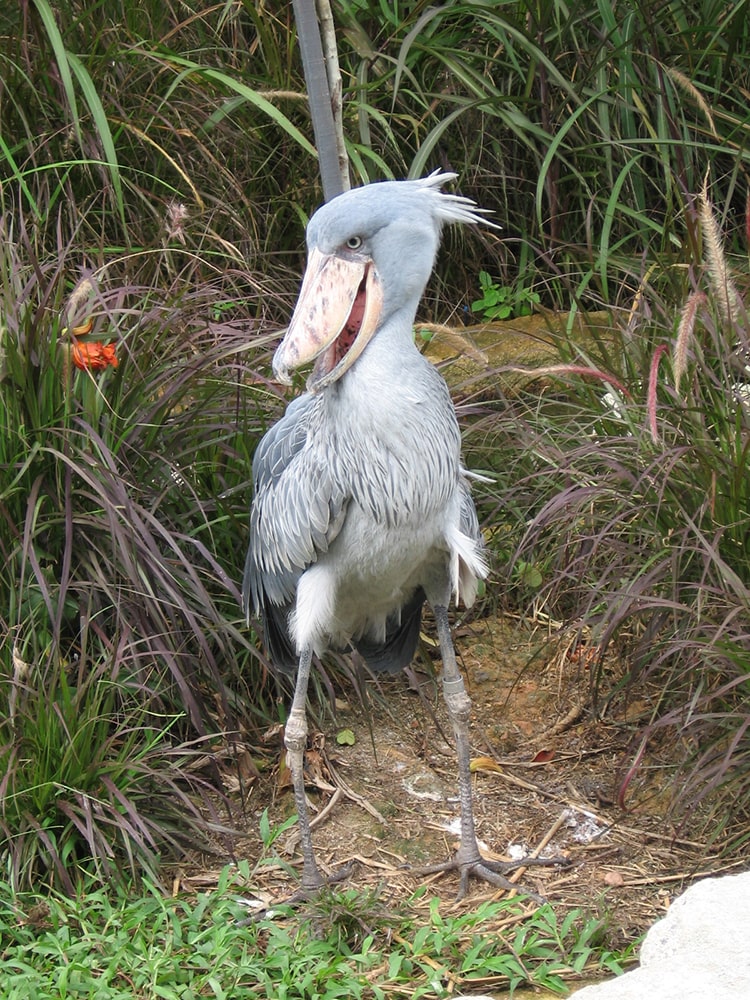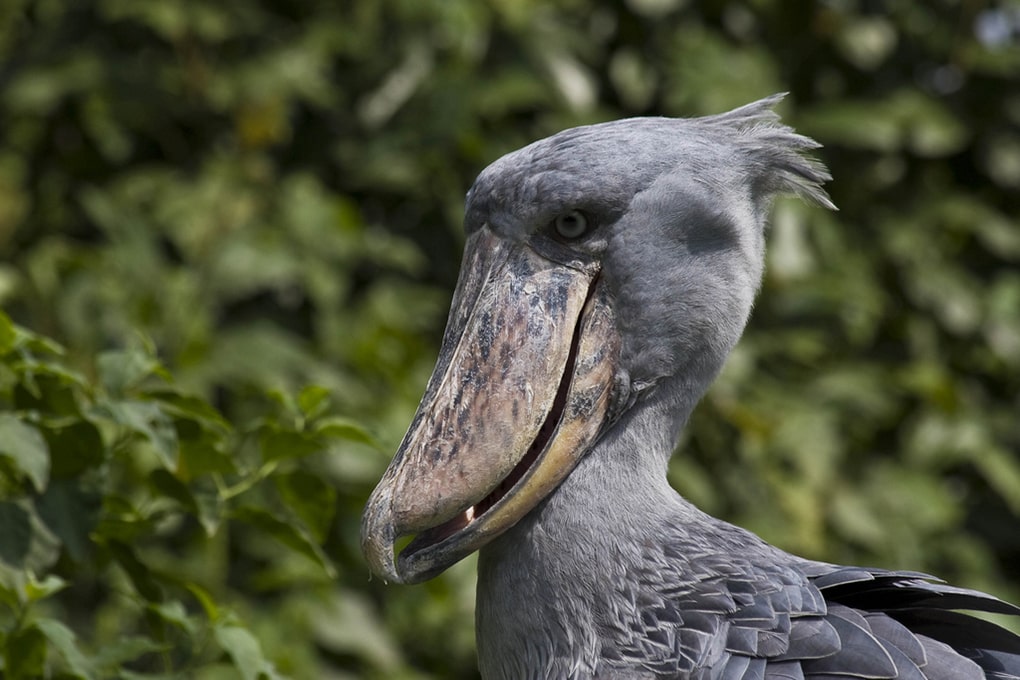At first glance, the shoebill as seen in the photo on the right comes across as a strange-looking bird. So, to get you better acquainted with this unusual bird, I have outlined all there is to know about the shoebill encompassing basic facts and distinctive features as well as weird behaviors.
Therefore, when you are done reading this post, the shoebill will not hold any more secrets!
The name, shoebill, comes from its shoe-shaped bill. However, the scientific name of the shoebill is Balaeniceps Rex, which was given by Gould in 1850, and means King whale head.
The shoebill has other names, such as the shoe-billed stork because it looks like a stork. However, the shoebill is sharing many features with the pelicans and herons.
However, when I look at the shoebill, I find that it looks like a bird made up of spare parts! No, really, the beak seems to come from a pelican, the legs from a flamingo, and the head from an eagle!
Take a closer look at the picture on the right and you’ll see what I mean! Do you see it?
The Shoebill’s Snapshot!
- Height: 43-55 inches (110-140 cm).
- Length from tail to beak: 39-55 inches (100-140 cm).
- Weight: 11-12 lbs (4.9-5.4 Kg).
- Wingspan: 7.7-8.6 ft (230-260 cm).
- Gestation period: 30 days.
- Lifespan in the wild: 35 years.
The shoebill’s population is between 5,000 and 8,000 in Africa. The shoebill is listed as vulnerable on the IUCN red list of threatened species, mainly because of its loss of habitat and poaching.

The King Whale-Head can be found in the following countries: southern Sudan, eastern Congo, Uganda, northern Zambia, western Tanzania, and Botswana.

The habitat of the shoebill includes the swamps, the marshes, and the wetlands, which are inaccessible areas, making the shoebill an elusive bird and the most sought-after by ornithologists and bird enthusiasts often going on a bird-watching safari in Africa to catch a glimpse of the shoebill!
Distinctive Features
The Bill
One of the distinctive features of the shoebill is without a doubt, the enormous bill. The shoebill possesses the biggest beak amongst all the birds on earth!
The bill as I mentioned earlier has the shape of a shoe and a length that can reach up to 9 inches (24 cm) by 4 inches (10 cm) wide. The beak harbors gray markings.
The sharp edges of the beak are quite useful to guillotine their prey, whereas the nail which has a hook shape and is found at the extremity of the beak is used to kill the prey!

The Feet
Another characteristic that stands out when you look at the shoebill is, its large feet! The middle toe has a length of 6.6 to 7.3 inches (16.8-18.5 cm) which helps with the shoebill’s balance, especially during hunting since it stands motionless for extended periods of time.
Shoebill’s Diet
The diet of the shoebill includes many species of fish such as its favorite dish, the lungfish, but also other species like the tilapia and the catfish. However, its diet is not limited to fishes and also comprises amphibians, snakes, lizards, rodents, and baby crocodiles!
The shoebill prefers to hunt at night and uses the ambush technique to catch its prey. Therefore, the King whale head usually stands over the floating vegetation or on the bank of swamps and waits for the fish.
Since the water is poorly oxygenated, the fish has to resurface to catch a gulp of air, and at that precise moment, the shoebill strikes with incredible speed and accuracy!
Because of the bird’s ability to stand motionless while it hunts, the shoebill has earned the nickname of a “statue-like” bird. So, if you are lucky enough to find the shoebill while on a bird-watching safari, you will be able to capture great close-up pictures!
Some Fascinating Behaviors
First off, the shoebill is known to be a silent bird. The only time the adult bird emits sounds is during the mating season by making bill-clattering sounds. As for the young chicks, they will make their presence known when they are hungry, and through sounds that resemble hiccups.
The shoebill is by nature a solitary bird as opposed to the heron and the pelican, which are living in a colony setting. The nests of the shoebill are far apart from each other; there are in fact only three nests per square kilometer!
The shoebill lays 1-3 eggs on a nesting platform made of vegetation. The size of the platform is about 3.1 to 3.5 ft (1 to 1.7 m) and is often submerged in water at a depth of up to 9.8 ft (3 m). Amazingly, the nesting platform is extremely sturdy since it can withstand a weight equivalent to an adult man!
Even though the shoebills lay up to 3 eggs, they predominantly take care of the egg that was the first to hatch, and keep the other birds as a backup plan in the event of the demise of the older chick!
Of course, this leads to sibling rivalry, where the firstborn abuses the younger siblings to affirm further its position! Usually, only one of the offspring makes it to adulthood!
Conclusion
The shoebill resembles a prehistoric creature that most bird enthusiasts are seeking while on a bird-watching safari in Africa.
The beak with its shoe-like shape is the most striking feature of the King Whale-Head and is predominantly used for hunting various prey.
If you are interested in going on a bird-watching adventure to catch a glimpse of the elusive shoebill as well as other fascinating birds along the way, click here to find out where to go for bird watching safari in Africa.
If you have any inquiries about the shoebill, please leave a comment below. I will get back to you promptly.
Hi Sonia,
That is quite an interesting species and a powerful sense of observation because it sure looks like a little bit of every bird. I’ve always been fascinated with birds and hoped to go on a safari. And while I find most birds to be harmless, the shoebill’s distinctive features amazed me. Being a “statue-like” should be considered a ‘talent.’ =) What are your thoughts about the California Condor?
Thanks for sharing! I sure learned a lot. I hope to see more of your educational inputs soon.
Rocky
You are right. It is quite a skill to stay still for an extended period. I don’t know anyone that can do that!
As for the California Condor, it reminds me a bit of the shoebill. Because at first glance, the Condor is not a very attractive bird. It is a strange-looking bird. It is also an endangered species.
The Condor portraits the image of a scavenger bird in my mind ever since I was a child. What I mean is that when I was a kid, I used to watch a lot of cartoons, like, for instance, Bugs Bunny and Lucky Luke. Every time something sinister was going to happen, like death, a California Condor was prowling nearby! For me, the California Condor embodies the image of what a vulture bird is.
What are your thoughts about the Condor?
Thanks.
Hi Sonia,
I really enjoyed reading your post, ‘Everything you Ever Wanted to Know About the Shoebill Revealed!’
Having lived in Africa many years ago, I was familiar with this funny looking bird and remember seeing one (pretty sure it was a Shoebill) on a visit to the Okavango Delta.
You are right though, it does look like a jumble of spare parts! 🙂
I do hope that it will one day very soon be removed from the list of vulnerable species.
Thanks for this wonderful and educational post.
Warmly, Heather
The Shoebills are mostly found in a war zone in the Republic of Congo and, therefore, targeted and killed by the rebels! By doing so, the rebels are preventing the conservationists from doing their jobs of taking care of the shoebills.
I think what would help the Shoebill to get off the endangered species list is for the conflict within the region to stop!
Unmistakably prehistoric looking! At first, I thought it resembled a wood stork. I am always amazed at animals that seem to be found only in tiny geographic areas. Being this particular bird it prefers to live in inaccessible swampy areas, I hope that means that they never have cause to worry about being on an endangered species list. Have to admit I was surprised at the nighttime hunting and can appreciate it’s intelligence.
Sonia,
Thanks for your posting about the “shoebill ” bird. I have learned so much from your interesting, well-written review.
It is a weird bird, that does look prehistoric, but cute nonetheless!
I found very interesting the part of your post about the laying of the eggs, and the hatching of the chicks. I was a bit taken aback by the fact, that the firstborn gets all the attention and food, and the younger siblings are barely kept alive just in case!
Thanks for sharing about the shoebill.
Brenda
The shoebill is a weird bird on many levels. First off, its looks, which takes some time to get used to. Once I got used to its overall appearance, I realized that the shoebill behaviors were a bit odd since it only takes care of their firstborn, therefore making the shoebill not worthy of any parenting awards!
And, I don’t think that the shoebill would be comfortable within the stratosphere of social media since it’s a solitary bird that only meets to mate!
You are right…..It does look like something out of the prehistoric age……looks like it is an extinct bird :). This is a really great description and some interesting features of a bird I had never heard of till now. I have always wanted to go on safari in Africa but never really had the time nor the money….One day maybe though 😉
Great Job
My first thought when I saw the shoebill was it looked like the extinct bird from Madagascar called the doo-doo! But after looking at an image of both birds side by side, I concluded that the shoebill and the doo-doo are quite different indeed!
A great article this is, I’ve liked it, especially the part where I read that the bird looks to you like it’s made of spare parts. I have laughed so hard on that remark.
Truly there are so many species of animals in the world and I don’t even know about them. This specie I have learned of just about now through reading your article.
Thanks for that, it is always nice to learn something new, makes me a more knowledgeable person.
Regards,
Ante
The shoebill is with its spare parts an endearing bird! This gives the shoebill a unique look for sure! I guess that if the shoebill were a car, it would be a hybrid!
One of the facts that I personally find amazing is its ability to stay motionless for a long period while hunting. I’m sure that many parents wish that their kids possess that skill at times!
Thanks for stopping by 🙂
Hi Sonia
What an amazing bird the Shoebill is – I love the fact that it’s prehistoric!
I found your article a gripping read, thanks for sharing.
We have some ancient animals and bird species in Australia too – have you been here yet?
Great job, I have shared this article on my Facebook
Kerrie
Thanks for sharing my post. I find the shoebill a cute bird, and I hope that the shoebill could be saved from extinction!
I have never been to Australia, and it’s on my bucket list to visit one day! I would like to go and see the ”ancient animals” that you have there along with gazing at the spectacular landscape!
Hi there Sonia,
I do see what you’re saying about the bird seeming to be made out of spare parts. lol. Kinda seems like the bird version of the Duck Billed Platypus. But hey, nothing wrong with that.
I think the weirder the animal is, the cooler and more unique it is. It seems these guys are a vacuum cleaner with wings. lol
Fun article and really well written! Keep up the good work and God bless!
Even though the shoebill has a peculiar look, there is something about the shoebill that makes it an endearing bird! I don’t know about the resemblance to a vacuum cleaner… I rather thought that the beak resembles more to a clog!